
Red-tailed Hawk adult
Belonging to an order of day-active birds of prey, hawks, eagles, and vultures have sharp, “toothed” bills designed to tear animals apart. All but vultures are also armed with mighty talons designed to grab and carry prey. Despite these formidable weapons, birds in this group are extremely gentle and nurturing with their chicks.

Red-tailed Hawk adult
To get close enough to mate, a male and female raptor must put themselves at the mercy of each other’s sharp bill and talons without a second thought.
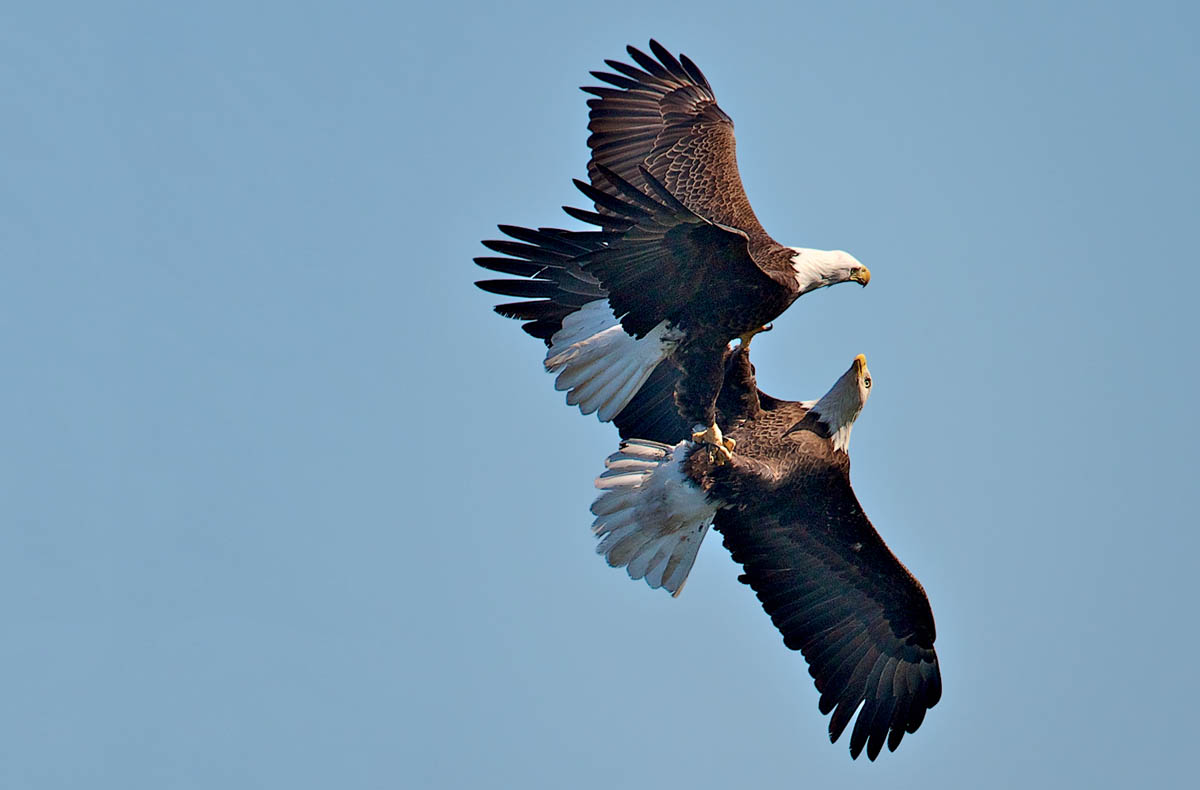
Courting Bald Eagles perform their dramatic cartwheel display. The birds soar to a great height, then lock talons and rapidly cartwheel or spiral together toward the ground. At the last minute, they release their grip, break away from each other, and swoop up into the air again.
To ensure survival of the species, hawks and their relatives have complex courting behaviors that start at a safe distance. The birds steadily draw closer only as both clearly signal that they’re focused on bonding and mating, not hunting. Displays include sharing sticks, working on the nest, vocalizations, and flight displays.
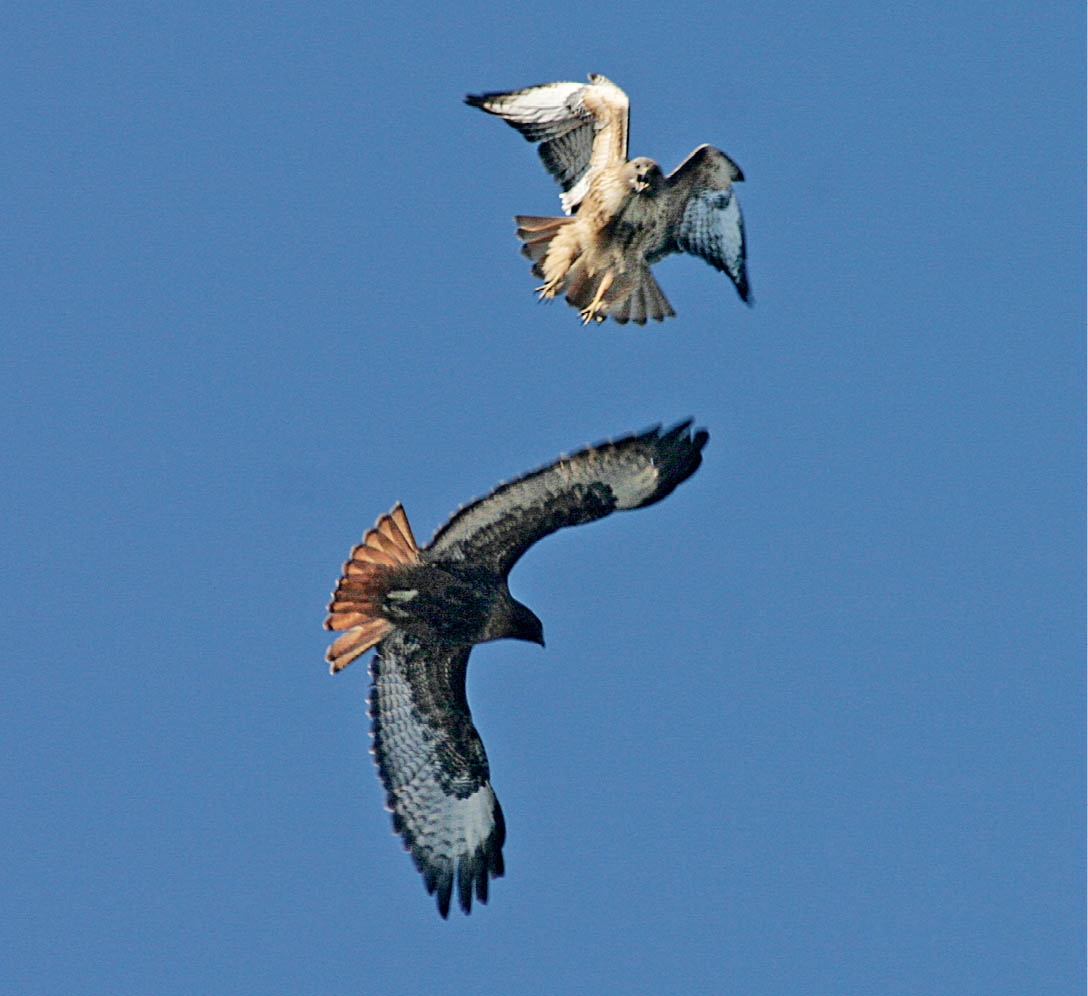
The Red-tailed Hawks’ dramatic sky dance begins with the courting pair soaring in wide circles together at high altitude. The male performs a series of steep roller coaster–like dives and climbs, then slowly approaches the female from above, extending his legs (as in this photo); he then touches or grasps her briefly.
As Bald Eagles increasingly commit to their mate, they perform spectacular sky dances with acrobatic flight displays and high-pitched screams. Once the pair is bonded and physiologically ready, they mate on the ground, a sturdy branch, or the nest.
Red-tailed Hawks have a thrilling flight display, too, males making a steep dive from great height, then shooting upward to do it all over again. Sometimes, the pair clasps one another’s beaks or talons and then spirals rapidly toward the ground before letting go and pulling away. Piercing screams or rasping calls often accompany the sky dance.
Flight displays not only help synchronize a pair’s hormonal levels and behavioral repertoire, but also assure each bird that its mate is completely trustworthy. Red-tails mate for life, but if one of the pair dies the other quickly finds a new partner.
Diurnal raptors choose a nest site with a good view of the surrounding landscape and open access from above. Rural red-tails build their nests in the tops of tall trees in mature forests, often near open country with agricultural areas, or on cliff ledges in areas where trees are scarce. In Arizona, they nest in tall saguaro cacti. Urban and suburban red-tails nest on a wide variety of artificial structures, including buildings, window ledges, utility line towers, stadium lighting pylons, windmills, and billboards.
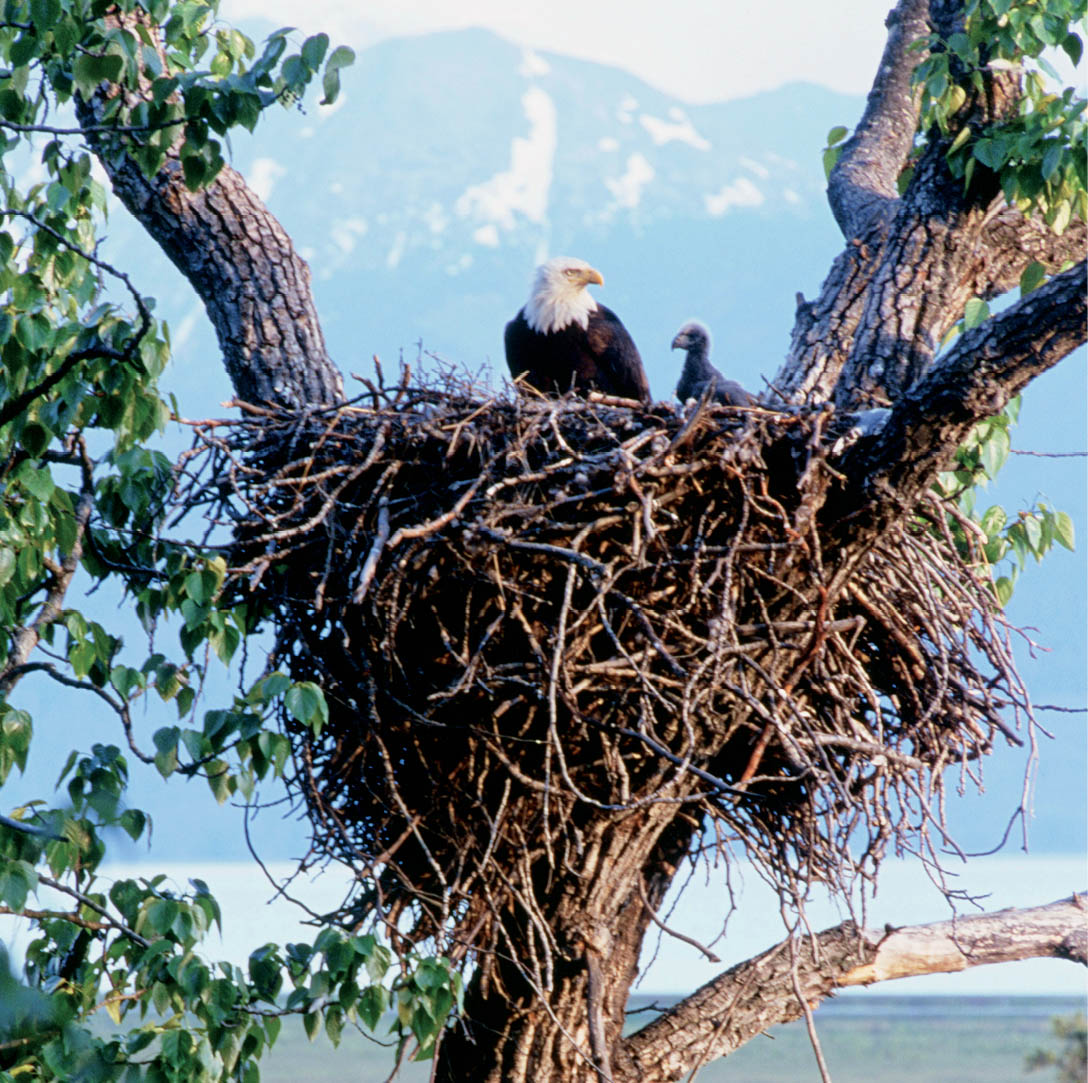
Bald Eagle nests are among the largest of all birds’ nests, usually 5 to 6 feet in diameter and 2 to 4 feet tall. The nest may take three months to build, and is often reused year after year, with the birds adding material so the nest becomes enormously bulky and heavy.
Hawks build their nests from sticks picked up from the ground or broken-off trees. Some species work sprigs of fresh greenery onto the nest to repel parasites or other pests or to signal to competitors, when the nest is unoccupied, that it is owned and currently defended.
Unlike hawks’ talons, vultures’ feet are not designed for carrying. Since these birds lay their eggs on the ground inside caves, under fallen logs, or in other large, protected crevices, they don’t need to carry nesting materials. Neither do they carry carcasses, since they feed on decaying meat on the ground where they find it, and then regurgitate it to feed their young.
These three diurnal raptors incubate for four or five weeks, starting with the first egg laid. That chick hatches first and grows for one to three days before the second hatches.
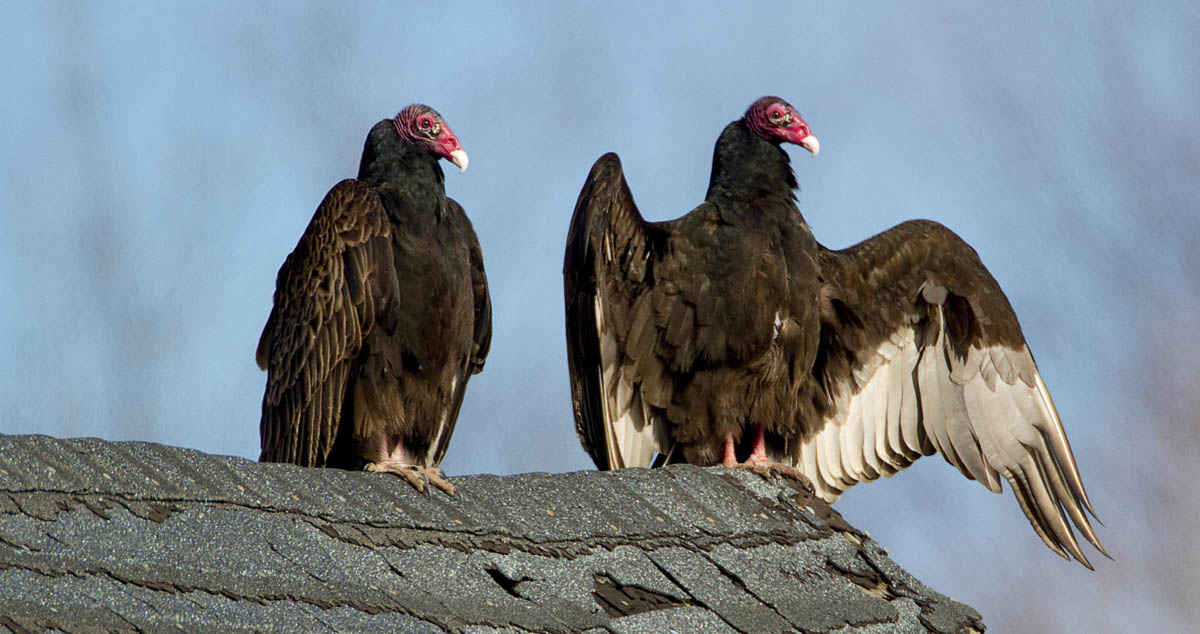
A Turkey Vulture pair sits together on the roof of a dilapidated building in which they will make their nest.
In nests with three chicks, the third rarely lives long enough to fledge because when it hatches, the older ones are already big and assertive. Hawks and eagles peck at smaller siblings. In lean times, older chicks may kill and even eat smaller ones, but when food is abundant, all three chicks may survive.
Eagle and hawk parents bite off tiny chunks of meat to feed the fluffy little nestlings, and as the chicks grow, they receive bigger scraps. Vultures consume decaying carcasses and then regurgitate them to feed their young. The chicks gobble the glop like the delectable baby food that it is to their palates.
When two mated birds don’t match in size, one can specialize in capturing larger, slower prey and the other can focus on smaller, quicker prey. Unlike in most species, with birds of prey the female is the larger of the pair, which has several advantages. She’s the one most often at the nest; her larger body makes her more effective at protecting the young. And during the physical act of mating, when the male balances on her back with his lethal talons, gripping her with his powerful beak, some ornithologists speculate that her larger size protects her. The size difference is most extreme in hawks that specialize in killing birds close to their own size.
Since female hawks are larger than males, they often take longer to fledge. Birds of prey need time and a lot of practice to get good at hunting. Juvenile red-tails stay with their parents for up to ten weeks after fledging, sometimes much longer where they are year-round residents.
Red-tailed Hawks consume a wide range of prey, from snakes to fairly large birds and mammals. Fledglings may be awkward hunters at first, but they learn fast. By mid-summer when they fledge, they can practice on abundant and inexperienced prey animals, such as baby rabbits.

A Red-tailed Hawk feeds two small, downy nestlings in their nest on a fire escape overlooking a park in the Bronx, New York. The young hatch covered with white down and with their eyes open. They are weak and helpless at first but soon can bob up and down, waving their wings and peeping excitedly when expecting to be fed.
Since Turkey Vultures eat carrion, they don’t have to worry about pursuing and killing prey. Young birds observe what adult vultures are doing, follow them to carcasses, and, little by little, learn the sights and smells that will help them detect dead animals on their own.
Bald Eagle young learn to pick up and feed on dead and dying fish floating on the water before they start catching live fish. Eagles also feed on carrion and soon learn how to find these meals with their keen eyes.
Eventually the young go their separate ways. Some researchers believe vultures mate for life, though it’s not known for sure. Bald Eagles may or may not wander south with their mates in winter, but they faithfully return to the same nest and mate as long as they both live. Non-migratory Red-tailed Hawks seem to mate for life, but it’s not certain whether migratory ones do.
Lunch is served. The female Red-tailed Hawk delivers a freshly killed rat to her nest on a Bronx fire escape. Urban red-tails make a good living dining on pigeons, rats, squirrels, and other small mammals found in cities, and thus play an important role in pest control.
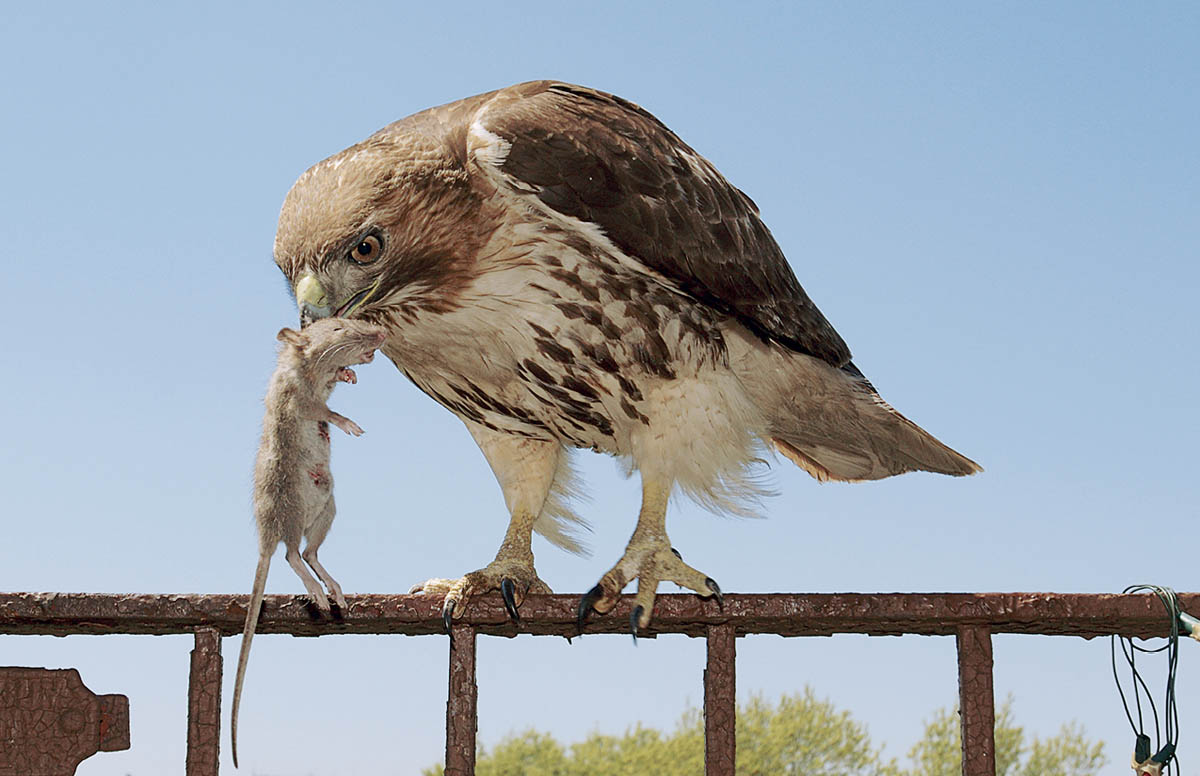
Direct Delivery. The female feeds her half-grown chicks at the nest. Feathers, still partly enclosed in sheaths, are visible on the wings. For the first four to five weeks, she tears apart and offers the prey (here, a chipmunk) piece by piece to the nestlings.
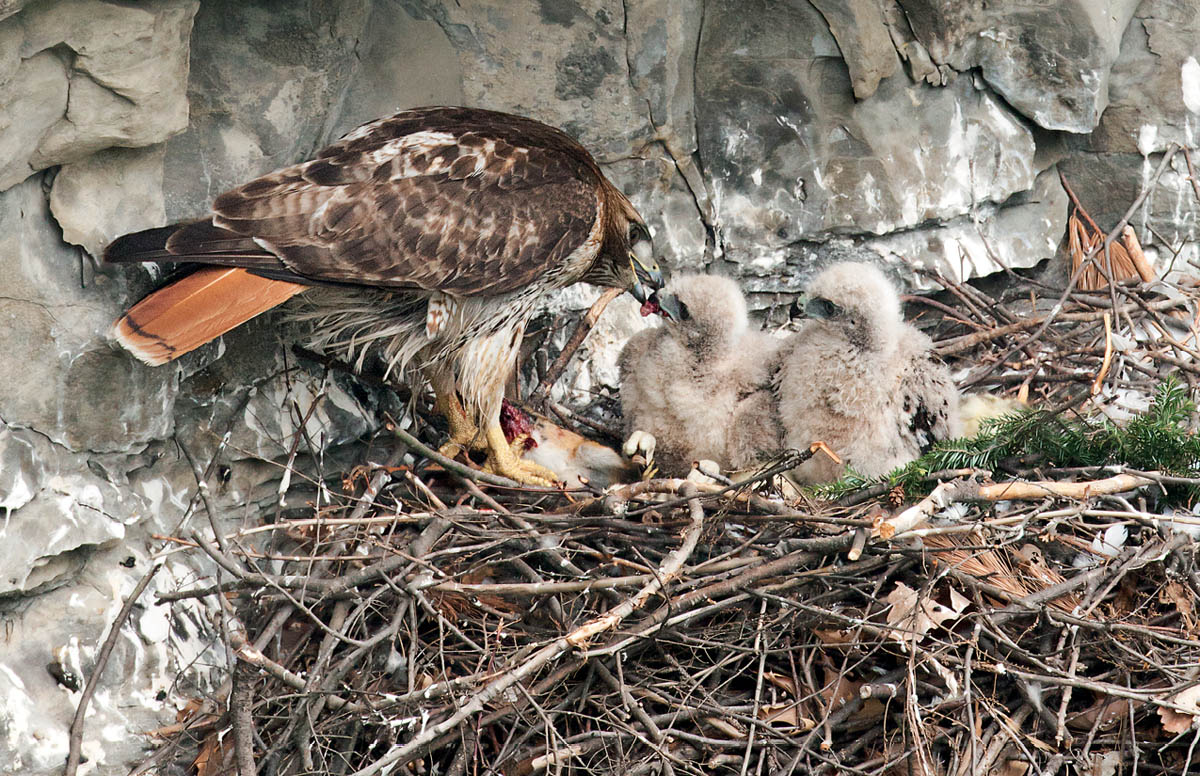
Flight Practice. By about 30 days of age, young red-tails regularly stretch and exercise their wings, even jumping up and down and flapping vigorously as if about to take flight. They leave the nest at 42 to 46 days old, but usually remain nearby, taking only short flights to follow their parents, begging for food. It may be two more weeks before they fly strongly.
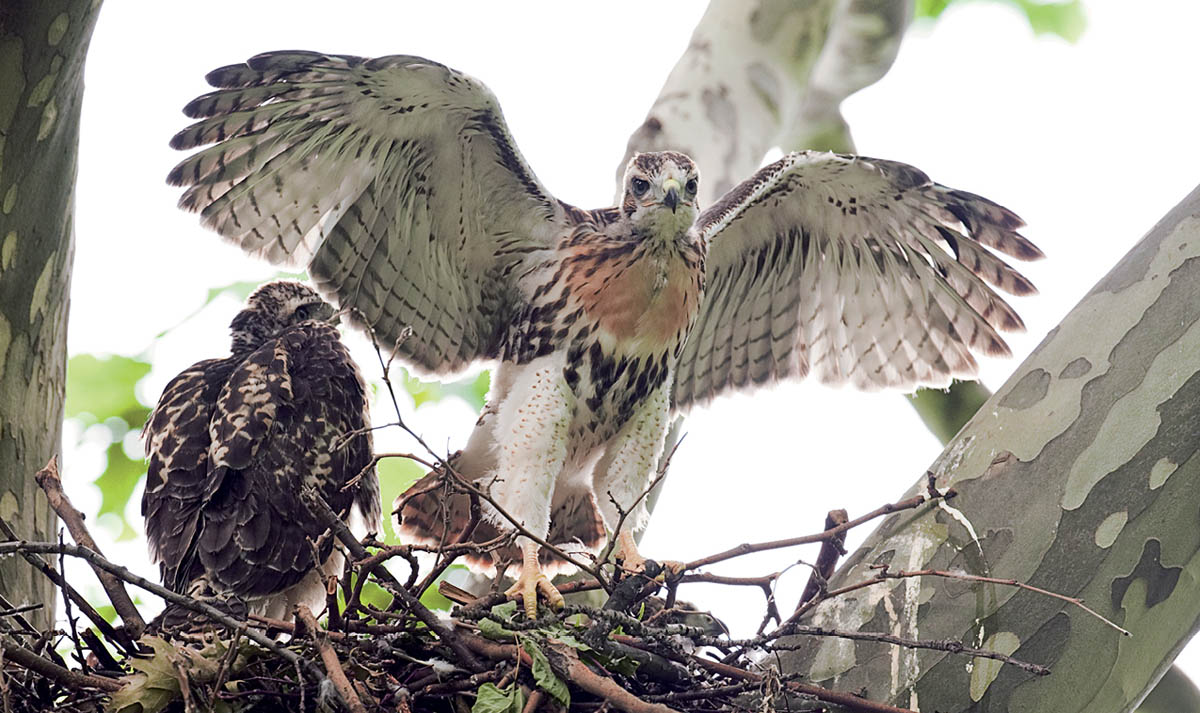
Hunting Success. A juvenile Red-tailed Hawk feeds on a Rock Pigeon. The young hawk makes its first hunting forays about four weeks after fledging, but it continues to get the majority of its food from its parents for about a month, until it is finally hunting successfully.
